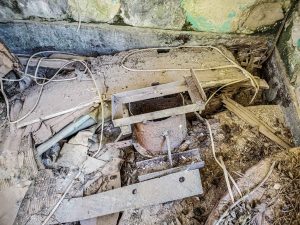The curtain is parting, the lights are dimming – it’s time to take your seat. You can hear people murmuring, whispering and rustling away at snacks. As darkness takes over the room, and the projectors begin to whirl, a collective silence takes over the space. A projection flickers onto the screen and some moving images appear. It’s time to forget the world, indulge in a bit of escapism and enjoy the show. Do you remember the magic of it was like to watch a film? With cinemas across the world shuttered due to the coronavirus crisis, we sought out a cinema that we could still enter and explore.
We travelled to a small island off Hong Kong to venture into this derelict old neighbourhood cinema. This is not just any cinema though, this is the only pre-war theatre left standing in Hong Kong and it is listed as a Grade III historical building, which means there is still a chance it could be demolished despite its heritage value. The two-storey structure was built in the early 1930s and it was popular with the islanders. During its heyday, screenings were often full. With only a rudimentary ticketing system and all 600 seats occupied, people often had to sit along the corridors and staircases. Tickets cost HK$10 per show and there was usually one screening during the day and two at night. It only took about eight staff to run the place. It is said the theatre owner imported the screen and installed it himself by reading the manual.
During this golden era, black and white films were shown in the theatre and there were often interpreters present to narrate and relay what was happening to audiences. The interpreter booth can still be seen on the right side of the screen near remaining seats in the photos. Outside the theatre, vendors would hawk snacks such as sugar cane, grilled squid, and sour plums. It was very much part of the community. Between 1941 and 1945 it was closed during the Japanese occupation. After reopening, it was business as usual until it was shut down in the early 90s. In 1992, it was sold and ownership was transferred. It has been left to decay in silence ever since, falling into further disrepair day by day. When we visited, it was in quite a state of dereliction – the original green plastic seats were scattered everywhere, with only a few remaining by the screen. Half of the roof had collapsed and the original beams and glazed tiles were nowhere to be seen. As a result, greenery has taken over and sunlight pours in where darkness used to be. Raw organic reality now pours into this space that was once reserved for escapism and the imagination.
It was not the only theatre on the island, but it is the only one of which anything remains. The theatre is constructed of concrete, bricks and rocks with walls and columns that support its pitch roof of black tiles. On the exterior above the reception lobby facing the street is a decorative façade. This has a geometric angled design topped off by subtle water patterns on either side. The name of the theatre is moulded into the stone and it matches the slanted shape of the roof beyond. Below this is the reception lobby, featuring red ceramic tiles and a modest ticket booth and movie poster display panels. A run-down screening room holding oxidizing projectors is located on floor above. Back on the ground floor at the far end beyond the lobby, the green seats lead up to a white screen. The side external walls are cement plastered and the internal walls are painted cream. Despite all these original remaining features, the cinema has fallen into an irreparable state of dilapidation.
Over the last few years the island has been branded as a tourism destination, and there was a plan to capitalise on this and revitalise the theatre and make it into a commercial development. However, this clearly has never come to fruition, and soon the historical value of site will be lost forever.









































